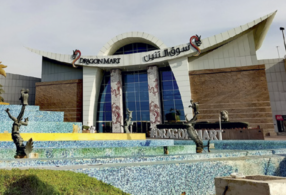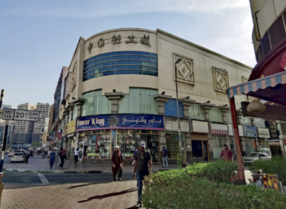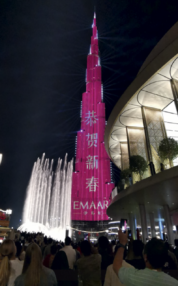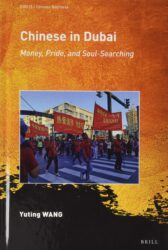Chinese in Dubai: Money, Pride, and Soul-Searching by Wang Yuting. Boston: Brill, 2020, 276 pages. ISBN-10 9004437711, ISBN-13 978-9004437715. Available from Brill and Amazon.
Wang Yuting published Chinese in Dubai: Money, Pride, and Soul-Searching when China was the third largest trading partner of the United Arab Emirates (UAE) and the UAE’s fourth largest tourist source market. Confucian Institutes offered lessons in Mandarin, Mandarin was being promoted in schools, Mandarin-speakers were employed in the large shopping malls and hotels, and PayPal was used extensively. Then covid broke and Wuhan was going into lockdown, so the book’s epilogue perhaps needs to be read first! The bulk of what was written is now more of a historical documentation of a pre-covid reality. The optimism and sense of a dynamic upward trajectory, in terms of Sino-Emirate relations and China’s ongoing ascendancy in the world, was interrupted as a rather different and unanticipated three years followed. It would be worthwhile both historically and sociologically to have a follow up piece of research that considers the impact of covid on the Chinese community in Dubai.
Wang Yuting was originally drawn to the region by the mystique of the Arabian tale of One Thousand and One Nights and a desire to “tread uncharted waters” (p. ix). She sought to fill the gap in the existing literature on post-1980s New China migrants in the Middle East, a little-studied region of Chinese immigration. She certainly does this. Based at the American University of Sharjah UAE, research was conducted over a period of ten years, between 2009 and 2019, in line with multi-year ethnology. How the study developed is considered at the start of the book along with the methodology—interviews (Ramadan 2016), use of WeiXin and other social media, and surveys. The research was designed to provide a sociological study of the Chinese community in Dubai: how they see themselves, are seen, and develop a sense of belonging while retaining pride in their Chinese identity.
The UAE covers an area of roughly the size of Chongqing Municipality but with less than a third of Chongqing’s population—a helpful comparison drawn by the author, who provides a brief overview of the history of the UAE and Dubai more specifically in chapter one. It is Dubai that is the focus, as the book’s title suggests. However, the background to the history of China’s relations and increasing presence regionally and in the UAE is presented. This crops up at various points and feels rather repetitive; tighter editing was required.
Exchanges between the two regions date back as far as 300 BC but there is no trace of this in the UAE (p. 61). A fascinating account tells of Ma Bufang, a Hui Muslim militia leader and warlord from northwest China, who took refuge in Saudi Arabia after the defeat of the Hui by the People’s Liberation Army in September 1949.1 Apparently King Saud IV requested the Emir of Sharjah to take in Chinese Muslim refugees, and these became assimilated, marrying into local families and obtaining citizenship.

In the 1980s, Chinese state-owned companies like Sinopec set up office. Chinese Muslims (particularly from Ningxia) proved useful “bridge-makers” with their religious affiliation and Arabic skills. In 1984, ambassadorial relationships were formed. A delegation from the UAE visited China as early as 1987. Traders largely from Zhejiang, Jiangsu, Guangzhou, and Fujian joined as “the new kids on the block” in the souqs of downtown Deira. Subsequently, in 2004, businesses moved to the flagship trading hub of Dragon Mart during the building boom and economic diversification prior to the 2008 slump. In the 2000s, Chinese corporations like Hua Wei and four Chinese banks were located in the financial heart of Dubai. The Chinese population expanded a hundredfold from 2,000 to more than 200,000, though exact figures are hard to ascertain.
Interestingly, as Wang points out, the UAE was generally considered to be a developing nation, with the challenges that implied. The Middle East was not one of the top or one of the more desirable destinations for Chinese as China opened and Chinese people began to travel more widely, establishing themselves and a China presence in different nations. Initially one of the pull factors was “the small pond migration strategy” (p. 109)—easier to get established with less competition despite not being at the center. However, as Dubai grew, so did its appeal. China’s own rapid growth also coincided with Dubai’s boom years—here was a place of potential opportunity both for individuals and the country.

The term “frontier mentality” was identified by Wang as a key shaper of Chinese thinking impacting migrants’ social trust, intergroup relations, sense of identity, and religious experiences. Here was opportunity— “a gold rush”—in the midst of desert heat, a very obviously different culture, and less regulated and less saturated markets. However, there was also the temporary nature of residence. While those of us who have long lived in China with a sense of impermanence are accustomed to its psychological effects, this is clearly a novelty for many Chinese. They identify with the term “expatriate” replacing the myriad other terms that Chinese tend to use (hua ren 华人, hua qiao华侨). Chinese are but one of many nationalities represented in the city and identified this way.
Dubai is not a long-term home but rather a potential stepping stone to elsewhere or means of earning money to return to a more comfortable life in China. This also influences decisions made regarding children—whether they are left in China to continue their schooling there or are brought along and placed in international schools with the hope of gaining access to higher education in another country where permanent residence can be secured. Chapter six looks at this subject more closely. A couple of fascinating insights are noted. Given Chinese stress on the importance of education, it is unsurprising that people question the Dubai education system, given that there was “not a single higher education institution until the 1970s” in the UAE (p. 88). There is also no Chinese school to be found in the whole country at the time of writing—surely an anomaly given the plethora of schools following the curricula of various other nations (p. 85). For all the transience common to all expatriates in the UAE, the Chinese have actively developed “Chinese spaces” (chapter 2). China has sought to make the most of the Chinese presence to establish “soft power” (chapter 6) and shape views.

A large portion of the book focuses on the perceptions of Chinese about both Islam and the Middle East and also the perceptions of Arabs and Emiratis about the Chinese and China. Many of the stereotypes in both directions are presented. Chinese have been considered “rich” (p. 89) with no consideration of the struggles and hard work involved in succeeding, “profit-driven” and “lacking morality” (p. 93), producing poor quality products (p. 93), and presenting a global “threat”. Meanwhile Dubai is perceived by the Chinese as exotic, mesmerizing, puzzling, unsustainable, and meaningless (p. 96). There is an ambivalence towards the Arabs and Islam by many Chinese who may also use stereotypical terms like “uncivilized” (p. 111), “developing,” and “low quality” (p. 112) in terms of education and cultural traditions (素质低).
Despite the tolerance that marks Dubai, Wang sees that the religious environment prompts many Chinese expatriates to do some soul-searching (chapter 4). For Muslims (Uyghur or Hui), it has meant being in an environment where they are “religious insiders” and part of a majority, which was never the case in China. They feel the pressure of having to be “good citizens” by Chinese standards as they are unofficial ambassadors (chapter 5). For those who are Christian, there is a greater sense of freedom. For those who have refrained from any religion, they may explore the Buddhism associated with China or other sects. For all, religious communities provide a way to find community and belong—and it is not simply about being with other Chinese people.
A number of individuals have their stories captured and told by Wang, which was a favorite part of the book for me. She observed, “the experience of individuals who make up the fast-growing Chinese community in the UAE is almost completely absent in academic discourse” (p. 15). Each person represents a different generation (1950s, 1960s, 1970s, 1980s, 1990s) and came to Dubai at a different period in the migration history. They are men and women, different religious persuasions but they have all made a contribution in some form or another, showing entrepreneurial spirit and a willingness to adapt. One, Xiao Liu, who grew up in Dubai in the late 1990s, commented:
People say that America is like a melting pot. I have a metaphor for Dubai. I think Dubai is like a stew pot that doesn’t melt anything. I am a carrot before being thrown into the pot. After being cooked together with curry and onions for a long time, I am still a carrot, albeit a carrot with the smell of curry and onion. I feel that I have acquired some attitudes and habits of the Arabs (p. 108).
While the book traces the Chinese community in Dubai and the views of those interviewed in the adjacent emirate of Sharjah, Chinese are most definitely found in other emirates and in growing numbers. The northernmost emirate of Ras Al Khaimah (in which the reviewer currently resides) has several Chinese grocery stores, a Chinese restaurant capturing a nostalgia for home-cooking (回家— “back home”), almost an entire block on hotel-filled Marjan Island rented by Chinese with Chinese hangings (对) on the main doors, and Chinese leafy vegetables and tofu for sale in some supermarkets, suggesting a Chinese clientele.
Anecdotally, it is said the Chinese here are involved in online gaming and gambling businesses reaching into China. It seems that as China once more opens up, there may be yet more who seek opportunities in this part of the world, and further study would be beneficial. It is almost certain that covid has led to further soul-searching for many Chinese, questioning the quest for money and causes for pride.
Our thanks to Brill for providing a copy of Chinese in Dubai: Money, Pride, and Soul-Searching by Yuting Wang for this review.
Endnotes
- See Julie Ma, “From the Middle East to the Middle Kingdom (6): From Warlords to Communists (1913–1949 and Beyond),” ChinaSource Blog, October 4, 2021, accessed April 20, 2023, https://www.chinasource.org/resource-library/blog-entries/from-the-middle-east-to-the-middle-kingdom-6/.
Image credit: Header image courtesy of the author; in-text images from Chinese in Dubai.

Andrea Klopper
Andrea Klopper has taught in South Africa, the United Kingdom, and China. She has mentored Mandarin language students and developed a cultural orientation and acquisition program which she used in two organizations. She is now being challenged to make friends in a new location and learning a new language. She …View Full Bio
Are you enjoying a cup of good coffee or fragrant tea while reading the latest ChinaSource post? Consider donating the cost of that “cuppa” to support our content so we can continue to serve you with the latest on Christianity in China.
